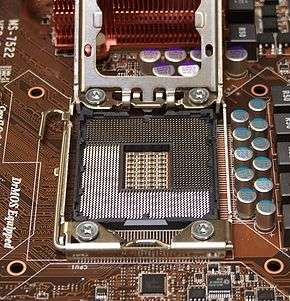LGA 1366
 | |
| Type | LGA |
|---|---|
| Chip form factors | Flip-chip land grid array |
| Contacts | 1366 |
| FSB protocol | Intel QuickPath Interconnect |
| FSB frequency | 1× to 2× QuickPath |
| Processor dimensions | 45 mm x 42.5 mm [1] |
| Processors |
Intel Core i7 (9xx series) Intel Xeon (35xx, 36xx, 55xx, 56xx series) Intel Celeron P1053 |
| Predecessor |
LGA 775 LGA 771 |
| Successor |
LGA 2011 LGA 1356 |
|
This article is part of the CPU socket series | |
LGA 1366, also known as Socket B,[2][3] is an Intel CPU socket. This socket supersedes Intel's LGA 775 (Socket T) in the high-end and performance desktop segments. It also replaces the server-oriented LGA 771 (Socket J) in the entry level and is superseded itself by LGA 2011. LGA stands for land grid array. This socket has 1,366 protruding pins which touch contact points on the underside of the processor (CPU)[4] and accesses up to three channels of DDR3 memory via the processor's internal memory controller.
Socket 1366 (Socket B) uses QPI to connect the CPU to a reduced-function northbridge that serves mainly as a PCI-Express controller. A slower DMI is used to connect Intel's most recent northbridge and southbridge components. By comparison, Intel's socket 1156 (Socket H) moves the QPI link and PCI-Express controller onto the processor itself, using DMI to interface a single-component "chipset" (now called PCH) that serves traditional southbridge functions. The difference in pin number is mostly a reflection of the number of memory channels served.
In November 2008, Intel released Core i7, which was the first processor requiring this socket.
LGA 1366 socket and processors were discontinued sometime in 2012,[5] and superseded by the LGA 2011 socket, on November 14, 2011, supporting Sandy Bridge E-series processors. LGA 1156 was discontinued at the same time.
Socket B mechanical load limits
Socket B processors have the following mechanical maximum load limits which should not be exceeded during heatsink assembly, shipping conditions, or standard use. Load above those limits will crack the processor die and make it unusable.
| Location | Dynamic | Static |
|---|---|---|
| IHS Surface | 890 N (200 lbf; 90 kp) | 266 N (60 lbf; 27 kp) |
Processors using this socket have a lower static load limit than previous models using LGA 775. Available reference heat sinks include circular design and heatpipe design.[6]
Supported chipsets
The desktop chipset that supports LGA 1366 is Intel's X58.
See also
- List of Intel microprocessors
- List of Intel Core i7 microprocessors
- List of Intel Xeon microprocessors
- List of Intel Celeron microprocessors
- CPU socket
- Nehalem (microarchitecture)
- LGA 1156
- LGA 1155
- LGA 2011
References
- ↑ "Intel Core i7 Processor Datasheet" (PDF).
- ↑ Socket Transition Guidance
- ↑ Intel Core i7 & i5 Compatibility Sheet
- ↑ "New P4 Socket Type LGA 775 (Socket T)". asisupport.com. Retrieved 2007-03-14.
- ↑ "Intel to discontinue LGA 1366 and LGA 1156 processors in 2012". December 8, 2011. Retrieved 2011-12-13.
- ↑ Loading Specifications page 28. Mechanical Drawings; page 52-69. From "Intel® Core™ i7-900 Desktop Processor Series and LGA1366 Socket Thermal and Mechanical Design Guide" by Intel